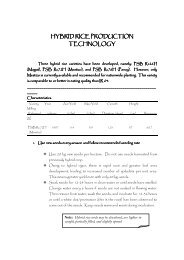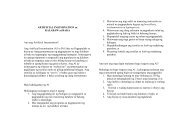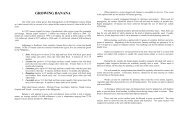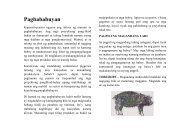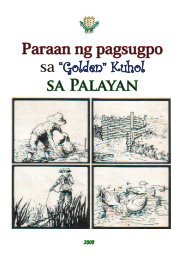GARLIC PRODUCTION GUIDE - Darfu4b.da.gov.ph - Department of ...
GARLIC PRODUCTION GUIDE - Darfu4b.da.gov.ph - Department of ...
GARLIC PRODUCTION GUIDE - Darfu4b.da.gov.ph - Department of ...
You also want an ePaper? Increase the reach of your titles
YUMPU automatically turns print PDFs into web optimized ePapers that Google loves.
Introduction<br />
Garlic (Allium sativum L.), otherwise known, as<br />
bawang is one <strong>of</strong> the more popular cultivated Alliums. It is<br />
mainly used as a condiment for flavoring meat, fish and<br />
salads, in fresh and dehydrated forms. It is also known to<br />
lower blood sugar and cholesterol levels. Its many other<br />
health-promoting attributes have resulted in medicinal pills,<br />
drinks and powders based on garlic extracts.<br />
Production and Trade<br />
Garlic is grown in about 5,700 ha mainly in Ilocos<br />
Region. In 1997, an average production <strong>of</strong> 15,760 t was<br />
reported. In 1996, 267.7 t valued at P 5.35 M were exported<br />
to the Netherlands and Singapore while 3,990 t <strong>of</strong> fresh and<br />
processed garlic valued at P68 M were imported.<br />
Production Management<br />
Strains<br />
Ilocos White<br />
Batangas Strain<br />
Cabuyao Strain<br />
Batanes<br />
Climatic and Soil Requirements<br />
Garlic grows best in areas with comparatively mild<br />
climate. It requires cooler weather during the early stages<br />
<strong>of</strong> growth and dry atmos<strong>ph</strong>ere with moderately high<br />
temperature for maturation. It can be grown from sea level<br />
to over 1,000 feet above sea level. Areas with Type I climate<br />
that is dry from November to April is best for commercial<br />
production <strong>of</strong> garlic.<br />
Garlic can be grown in several types <strong>of</strong> soil. It<br />
grows best in sandy loam and silty loam to clay loam with<br />
pH <strong>of</strong> 5.6 –6.8. The soil should be fertile, rich in organic<br />
matter, well drained and maintain good soil moisture supply<br />
during the growing period.<br />
Land Preparation<br />
A 1-ha production area requires 1,000 kg garlic<br />
seed pieces.<br />
With thorough tillage, the land is prepared 4-6<br />
weeks before planting. The field is plowed 2-4 times at 7<br />
<strong>da</strong>ys interval to improve soil texture. The use <strong>of</strong> tractor<br />
driven implement requires 1-2 plowing and harrowing<br />
operations while an animal-drawn harrow needs 4 passing.<br />
Apply animal manure at 10-15 t/ha prior to bed preparation.<br />
Mulch with 3-5 cm layer <strong>of</strong> rice straw after planting to<br />
conserve moisture and control weeds. This method <strong>of</strong> land<br />
preparation is appropriate for upland areas.<br />
Zero-tillage is usually practiced in lowland rice<br />
fields. Cut straw and weeds close to the ground after rice is<br />
harvested. Allow soil to dry until desired moisture level is<br />
attained. Construct canals around the paddies to make sure<br />
that no standing water will stay in the paddy after irrigation<br />
or heavy rain.<br />
Fertilization<br />
In the absence <strong>of</strong> soil analysis, a 1-ha production<br />
area requires 7 bags <strong>of</strong> complete fertilizer (14-14-14), 2 bags<br />
<strong>of</strong> Urea (46-0-0), 2 bags <strong>of</strong> super<strong>ph</strong>os<strong>ph</strong>ate (0-18-0) and a<br />
bag <strong>of</strong> muriate <strong>of</strong> potash (0-0-60). Apply all 0-18-0 and 14-<br />
14-14 as basal fertilizer prior to planting. Apply a<br />
combination <strong>of</strong> 46-0-0 and 0-0-60 at 30,50 and 70 <strong>da</strong>ys after<br />
planting.<br />
Irrigation<br />
Irrigate lightly but frequently with 25 cm <strong>of</strong> water<br />
per week to provide continuous and uniform moisture<br />
supply throughout the growing season. Regulate watering<br />
at the onset <strong>of</strong> bulb formation to ensure proper ripening.<br />
Stop irrigation when tops begin to fold over, otherwise, it<br />
will result in watery bulbs, increased rotting and reduced<br />
keeping quality.<br />
Pests and Disease Management<br />
Purple blotch (Alteria porri) and Cescospora leaf spot<br />
(Cercospora duddiae). Select healthy planting materials.<br />
Control humidity within the field with lower planting<br />
density and proper irrigation. Spray with compost tea<br />
(Compost tea is prepared by fermenting rice compost for 10-<br />
14 <strong>da</strong>ys. The effluent is sprayed to control foliar diseases).<br />
Remove infected leaves.<br />
Black mold (Aspergillus niger), basal rot (Fusarium<br />
oxysporum) and bacterial s<strong>of</strong>t rot (Erwinia carotovora).<br />
Harvest only matures bulbs. Cure harvested bulbs properly.<br />
Maintain good air circulation during curing, packing and<br />
storage.<br />
Thrips (Thrips tabaci), army worm (Spodoptera<br />
exigua) and cutworm (Argotis spp.). Use overhead irrigation,<br />
spray with water and soap solution at high pressure.<br />
Remove thrips infested leaves. Spray with hot pepper<br />
extract and spread ash on the soil around the plant at<br />
regular intervals to control armyworm and cutworm<br />
infestation. Manage weeds properly to maintain sufficient<br />
population <strong>of</strong> natural enemies <strong>of</strong> insect pests.<br />
Harvesting<br />
Harvest when 75% <strong>of</strong> the leaves turn yellow and<br />
begin to fold over. Pull bulbs manually from the soil at<br />
about 90-100 <strong>da</strong>ys after planting.<br />
Post harvest<br />
Cure harvested bulbs for 10-14 <strong>da</strong>ys under dry<br />
shade. Proper drying is essential to minimize diseases<br />
during storage and to produce good skin color. After<br />
curing, cut leaves 10-12 cm from the top <strong>of</strong> the bulb. Grade<br />
bulb according to size and quality and store in a wellventilated<br />
area. Storage <strong>of</strong> bulbs layered with lagundi leaves<br />
prevents <strong>da</strong>mage caused by storage pests such as cigarette<br />
beetles.
Cost and Return Analysis Per hectare<br />
ITEMS AMOUNT (P)<br />
I. VARIABLE COSTS P113,030<br />
A. Labor (P150/MD)<br />
Plowing 1,500<br />
Harrowing 1,000<br />
Bedding 1,500<br />
Manure Application (4MD) 600<br />
Fertilization; basal (4MD) 2,100<br />
& Side-dress (10MD)<br />
Preparation <strong>of</strong> planting<br />
materials (5 MD) 750<br />
Seed piece treatment (1 MD) 150<br />
Planting (25 MD) 3,750<br />
Mulching (5 MD) 750<br />
Irrigation (14 MD) 2,100<br />
Spraying (20MD) 3,000<br />
Weeding ( 30 MD) 4,500<br />
Post harvest operations<br />
(35 MD) 5,250<br />
Sub-total 29,950<br />
A. Materials<br />
Seed pieces (1,000 kg/ha) 50,000<br />
Animal manure (15 t) 15,000<br />
Fertilizers<br />
14-14-14 (7 bags) 2,450<br />
46-0-0 (2 bags) 930<br />
0-18-0 (2 bags) 1,100<br />
0-0-6- (1 bag) 600<br />
Rice straw (20 trailer-load) 3,000<br />
Fuel and Oil 5,000<br />
Miscellaneous 5,000<br />
Sub-total 83,080<br />
II. FIXED COSTS 18,063<br />
Land Rental 5,000<br />
Depreciation<br />
5 pcs. Scythe (2 yrs) 63<br />
5 pcs. Hoe (3 yrs) 125<br />
3 pcs. Shovel (3 yrs) 75<br />
2 knapsack sprayers (5 yrs.) 800<br />
Interest on loans at 20% int. p.a. 12,000<br />
TOTAL COSTS 131,093<br />
GROSS INCOME a 200,000<br />
NET INCOME b Y1 = 68,907<br />
Y2 = 118,907<br />
_____________________________________<br />
a With marketable yield <strong>of</strong> 4 t/ha at P 50/kg<br />
b year 2 total costs exclude item on seed pieces<br />
Source: Information Bulletin No 198./2000<br />
Garlic Production<br />
PCARRD<br />
Reproduced By<br />
DEPARTMENT OF AGRICULTURE<br />
REGION IV-B<br />
(MiMaRoPa)<br />
2005<br />
Production Guide



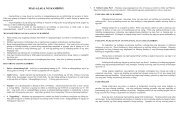
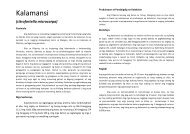
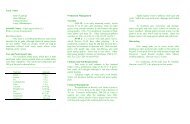
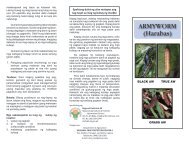
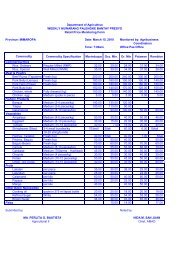
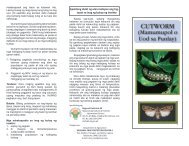
![Quick Guide-Yellow Corn Final 2-tagalog [Compatibility Mode]](https://img.yumpu.com/42848209/1/190x134/quick-guide-yellow-corn-final-2-tagalog-compatibility-mode.jpg?quality=85)

